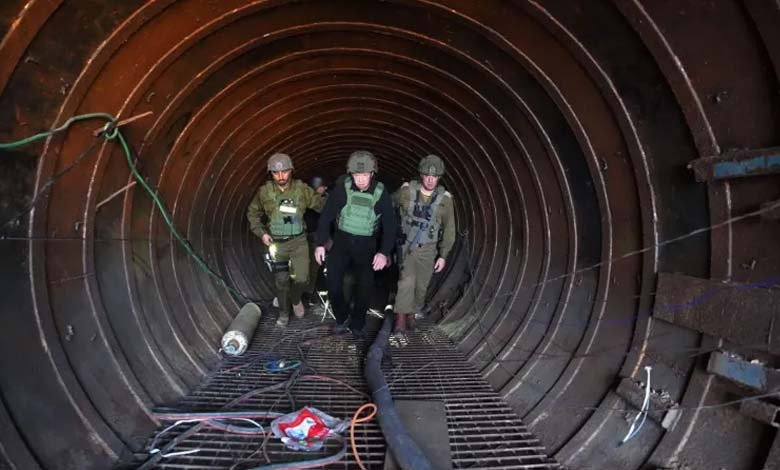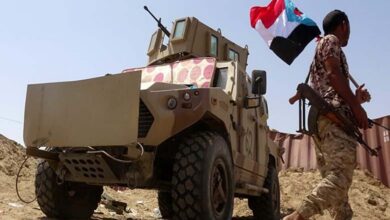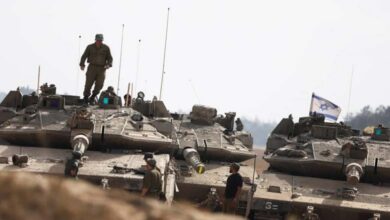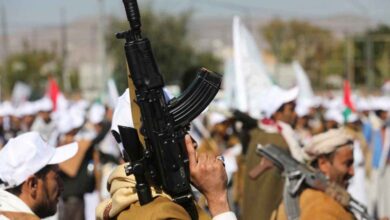Gaza Tunnels: Changing the direction of wars?

The tunnels of Gaza are redefining the value and nature of ground combat, presenting different criteria for underground warfare as another facet of secret conflicts.
Since October 7th, Hamas has drawn Israel into one of the worst tunnel wars ever, revealing now the unprecedented scale of its underground network.
It is believed that this network has delayed the victory promised by the Israeli government, imposing unimaginable diplomatic and political costs over eight months of war.
The current tunnel war can only be compared to World War I, where countless British and German soldiers died trying to uncover, mine, and dig tunnels, according to a report by the American magazine “Foreign Affairs.”
The magazine emphasized that Hamas‘s use of tunnels is extremely advanced and surpasses what is usual for non-governmental actors, closely resembling the way states use underground structures to protect command and control centers.
Hamas‘s enhancement of its underground capabilities has shaken Israel’s assessment of tunnel threats, not imagining it would be involved in a war of this scale. Israel had focused solely on removing tunnels that penetrated its territory.
It is likely that the Gaza war will stimulate the development of new doctrines and new methods to deal with this unique type of warfare.
Equipped Tunnels
After overcoming most of the obstacles of underground warfare, such as communications, low oxygen levels, claustrophobia, etc., this tactic is expected to continue to spread.
According to the magazine, Hamas‘s use of tunnels has redefined the strategic value of the surface and military confrontations, as well as the use of human shields.
It is certain that staying underground for long periods is not easy. Ukrainians in the tunnels under the Azovstal plant in Mariupol in 2020 did not last more than two months due to lack of food, water, sanitation, internet, and communication with the outside world.
These aspects did not pose a problem for Hamas fighters who remained underground for nearly eight months, breaking all records.
This is due to a labyrinth of equipped tunnels including dormitories, meeting rooms, ventilation and electricity, toilets, showers, plumbing systems, and rudimentary but effective communication networks, along with massive stocks of fuel, food, and water.
This allowed living and conducting military operations while ensuring continuous weapon supply and distribution.
Hamas overcame geological constraints, technical difficulties, and fear, having had enough time to refine, test, and improve its skills, showing that years of training and meticulous planning can help overcome obstacles.
Generally, tunnel users leave them, but Hamas leaders are barely visible above ground. In April, reports indicated a brief visit by Hamas leader in Gaza, Yahya Sinwar, to his forces above ground.
It is unclear how often Hamas fighters emerged from the tunnels for resupply or rest, but it is certain that the movement managed to direct military operations without interruption and maintain the command chain despite Israeli strikes disrupting its communication systems.
Hamas‘s use of tunnels resembles states’ use of permanent underground bunkers as command and control centers in crises, hosting leaders and producing weapons in emergencies. Canada, China, Iran, Israel, Russia, and the United States possess these types of bunkers.
Conversely, terrorist groups use rudimentary tunnels to evade surveillance technology, hide, and carry out surprise attacks.
The tunnels discovered by Israel in Gaza resemble underground structures in Iran and North Korea in terms of size, depth, and construction, with a distinctive arched concrete roof, using cement to build larger tunnel passages.
For Hamas, tunnels are a long-term strategic investment ensuring the continuity of its command chain during the war, far more than a mere tactic to counter Israeli intelligence, surveillance, and reconnaissance capabilities.
Reducing Surface Importance
In many ways, tunnels have shaped operations in Gaza, undermining chances of a quick Israeli victory, slowing operations, complicating hostage rescue, and creating complex military and political environments for Israel.
But the often overlooked aspect, with severe consequences for future wars, is the reduction in surface importance, this new form of warfare taking place on “two different levels.”
At the beginning of the war, the Israeli army sought to control the surface to uncover and enter Hamas tunnels. But as its forces advanced, the surface became just an access point to tunnels and no longer the focus of combat.
This does not mean Hamas fighters will never appear, as they launched deadly anti-tank missiles and carried out other types of ambushes.
Invisible traps near tunnel passages indicate the presence of Hamas fighters, but they are not in sight. Penetrating tunnels moves the enemy to a different part of the network.
This type of warfare could recur, forcing armies to think about how to handle the diminishing role of the surface when the enemy moves from tactical to strategic underground use.
The surface will remain an essential part of warfare, at least in terms of access to tunnels and as the final site of most confrontations. However, recent developments suggest it is better to treat underground warfare as a distinct domain rather than a mere branch of ground operations.
Technological Limits
The Gaza war showed that Israel’s possession of the world’s most advanced anti-tunnel technology did not deter Hamas.
In 2018, Israel deployed advanced detection and neutralization technologies to counter Hezbollah’s tunnel threat. It also trained special units for tunnel warfare, built underground training facilities, developed underground sensors to protect its borders, and mapped tunnels using drones.
But this technology did not prevent Hamas from investing time and human resources in building tunnels. In fact, it led Israel to believe it had crushed Hamas’s covert activities, while the opposite was true as Tel Aviv focused on tactical aspects, leaving Hamas free to develop its unprecedented underground capabilities.
Hamas knew its vast tunnel network in Gaza would slow Israel’s response, reduce its competitive advantage, and protect movement leaders.
Human Shields
Since October 7th, Hamas has held hundreds of hostages, which “Foreign Affairs” claimed were taken into tunnels as human shields. The aim of placing them in tunnels was to complicate rescue efforts, restrict military operations, and protect Hamas‘s key military assets.
-
Israel’s Alternative Plan in Rafah: Secrets of American Negotiations to Stop Occupation Massacres
-
Israel Declares War in Gaza Until at Least the End of 2024
This maximized Hamas‘s political and military goals far beyond its declared objective of freeing Palestinian prisoners from Israeli jails.
Hostage detention has torn Israeli society apart, linking the government’s victory to unattainable and non-negotiable goals. This gave Hamas leverage at the negotiation table, pushed Tel Aviv’s allies to demand concessions for hostage release, and facilitated the psychological warfare conducted by the movement.












